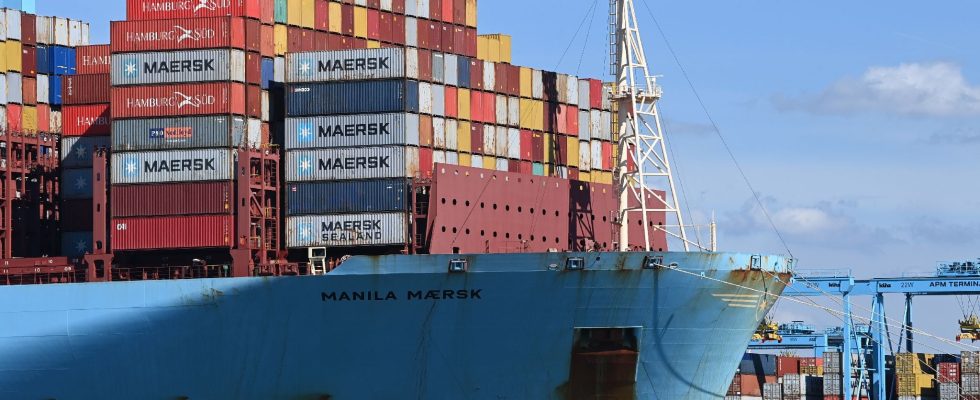With the response from Washington and London on Friday January 12 to the repeated attacks by the Yemeni rebels, tension rose further in the Red Sea. For its part, the manufacturer Tesla announced that its production of electric cars in Germany would be suspended for two weeks, from January 29 to February 11, due to failure to receive the necessary parts in its factory near Berlin. The unrest in this maritime area is forcing many ships to change their route to head towards the Cape of Good Hope, at the southern tip of Africa, which considerably lengthens their route. However, the analysis of risks by insurers shows that the situation is currently less critical than in the Black Sea, at the heart of the Russian-Ukrainian conflict. Explanations from Mathieu Berrurier, general manager of the specialist maritime insurance broker Eyssautier-Verlingue.
L’Express: How are the insurers who cover ships and their goods reacting to the situation in the Red Sea?
Mathieu Berrurier: Having the point of view of these experts is particularly interesting because their evaluation makes it possible to measure the intensity of the risk at a given time. All shipowners and shippers are in principle insured against “war risks”, this is i.e. damage to ships or goods that arises from events linked to conflicts or geopolitical tensions. These contracts are annual, for a basic premium which is generally very low. Then, each insurer has its own risk evaluation and grading system, on a scale of 1 to 8. Depending on its analysis, the premiums evolve.
Initially, they increase with the estimated severity. Once you reach a level of 7 or 8, insurers say “stop” and only cover on a case-by-case basis. Because – and this is a particularity – in the event that an armed conflict breaks out, the “war risk” insurer has the possibility, following two to seven days’ notice, to suspend coverage. If he nevertheless grants his client authorization to transit through war zones, he then applies an additional premium, which can be very high.
Is this what happened in the Black Sea, with the war in Ukraine?
In the Black Sea, we immediately found ourselves at level 8. Even today, insurers’ analysis reveals a much higher risk in the Black Sea than in the Red Sea, for two reasons. The first because the Black Sea is a trap, it is a hole inside which ships go to ports, sometimes mined, to load and unload. The risk is maximum. Second reason: it is the Russians who are opposite, a real potential strike force.
Conversely, in the Red Sea, ships do not face a destination risk but a transit risk – they pass offshore. In addition, the attacking power is the Houthis, whose capabilities are much less than those of the Russians: there has been talk of around twenty drone attacks, but for the moment, none have had dramatic consequences. . If they were to carry out twenty serious attacks, the Russians would send fifteen boats into the depths! The risk therefore seems much lower and moreover, if certain insurers have chosen to apply an additional premium for goods transiting the Red Sea, others, to date, do not yet do so. On the other hand, all apply a surcharge to the passage of ships in this area.
However, the premiums charged by insurers have increased. In what proportion?
To give an idea, the basic premiums have been multiplied by 10, but the amounts remain limited. In any case, this increase is not strong enough to dissuade a shipowner from passing through the Red Sea and the Suez Canal. Shipowners who make this choice put forward other arguments, such as crew safety. In all cases, this implies significant increases in freight rates. Going via the Cape of Good Hope means a lot of extra sea, a lot of extra fuel oil, it disrupts the transport chain. Not to mention that diverting the ship can be more costly than not diverting and possibly paying an additional insurance premium.
In the end, it is not the shipowner who bears these additional costs: they are passed on to each of the participants in the supply chain. This is of great concern to Chinese exporters because if this crisis were to become widespread and amplified, it would affect the competitiveness of their products, between delivery times and the increase in prices due to the cost of transport or insurance. Do you remember that when Covid came out, many containers were stuck in major world ports because everything was disorganized? We are moving towards the same kind of pattern. In a commercial port, everything is planned to receive a certain number of containers per day. With the ships diverted, the containers arrived three weeks later, in enormous quantities.
If the conflict became widespread, insurers would therefore be more selective?
Yes, they would adopt a much more severe position, like what we are already observing in the Persian Gulf for example, where they consider that we are permanently in a risky zone. The Red Sea would become a region of the world where insurance rates would become sustainably higher, or even where insurers would stop covering ships.
Are there other areas to be particularly monitored?
Maritime transport accounts for 80% of merchandise trade in the world. So the slightest grain of sand can cause difficulties. The China Sea is a subject of vigilance for insurers, as are other phenomena. Due to the unrest in the Red Sea, many boats are returning along the African coast, to the west of the continent, and we have seen a certain increase in acts of piracy in the Gulf of Guinea. It’s a piracy different from that which we experienced in the Horn of Africa, in Somalia. It’s more about theft, pilfering. By bypassing certain places, we increase the risks elsewhere.
.
